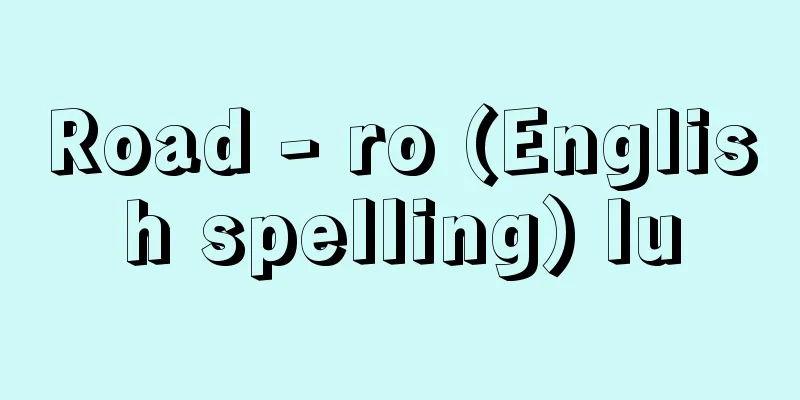The Great Kanto Earthquake

|
A major earthquake struck southern Kanto at 11:58 a.m. on September 1, 1923 (Taisho 12). [Junichiro Kizaka] Damage SituationThe epicenter was in the northern part of Sagami Bay (139.3 degrees east longitude, 35.2 degrees north latitude), and the earthquake's maximum intensity was 7, with a magnitude of 7.9. As it was lunchtime, fires broke out in 134 places due to the collapse of houses caused by the earthquake, and the fires were extinguished at 2:00 pm on September 3rd. During that time, the temperature rose due to the large fires, reaching 46°C in Tokyo by midnight on the 1st, and 936 aftershocks felt by humans had been recorded between the initial earthquake and 6:00 am on the 5th, and tsunamis struck various areas. As a result, the Keihin area, the heart of Japan, was devastated, and the damage extended to one prefecture and six prefectures, including Tokyo, Kanagawa, Chiba, Saitama, Ibaraki, Shizuoka, and Yamanashi. According to the Tokyo City Hall's Tokyo Earthquake Record, Vol. 1 (1926), the number of victims was approximately 3.4 million (29% of the population of the 1 prefecture and 6 prefectures, of which 93% was in Yokohama and 75% was in Tokyo), with 91,344 deaths, 13,275 missing, 16,514 seriously injured, 35,560 slightly injured, 381,090 households completely burned, 83,819 completely destroyed, and 91,232 partially destroyed, with damages estimated at more than 5.5 billion yen. When you compare this with the general account budget for fiscal 1922, which was approximately 1.47 billion yen, you can see just how enormous the damage was. [Junichiro Kizaka] Historical backgroundAfter World War I, Japan was facing a deepening crisis due to the rise of the Taisho Democracy Movement, which led to the organization of popular movements, the rise of right-wing opposition to this movement, the destabilization of the imperial system triggered by the assassination of Prime Minister Hara Takashi and the death of Elder State Elder Yamagata Aritomo, and the blow of the postwar depression. Externally, Japan was becoming internationally isolated due to the deepening conflict with Britain and the United States under the Versailles-Washington system, the intensification of anti-Japanese national liberation movements in Korea and China, and the disastrous defeat of the Siberian Intervention. The Great Kanto Earthquake, which occurred suddenly under these circumstances, was not only a natural disaster, but also had great historical significance in that it had a decisive impact on various aspects of the economy, politics, and society. [Junichiro Kizaka] Relief and reconstruction efforts under the second Yamamoto CabinetThe second Yamamoto Gonbei Cabinet, which was formed on September 2nd, the day after the earthquake, was a detached cabinet, but it emerged as a cabinet of talent, with Home Minister Goto Shinpei, Finance Minister Inoue Junnosuke, and Communications Minister Inukai Tsuyoshi, among others, and on the same day it imposed martial law around Tokyo, issued emergency requisitions, and embarked on relief and reconstruction efforts.Firstly, on the economic front, on the 7th it enacted an order to crack down on excessive profits and a 30-day moratorium on payments, thus avoiding chaos in the business world for the time being, and on the 11th it promulgated an order to exempt rice from the import tax, on the 12th an order to reduce or exempt import taxes on daily necessities and on civil engineering and construction equipment, machinery, and materials, and on the 22nd an order to temporarily supply supplies and a special account for the same. Furthermore, on the 27th, the government rescued banks by issuing the Bank of Japan Earthquake Bill Discount Loss Compensation Order, which stated that the Bank of Japan would undertake the re-discounting of bills payable in the disaster area, and that the government would compensate the Bank of Japan up to 100 million yen of any losses it suffered in this process. However, by the end of March 1924, the Bank of Japan's earthquake bill discount amounted to 430.81 million yen, and the number of discounted banks reached 105, which led to an expansion of the currency, and later many of the earthquake bills became uncollectible, which was the direct cause of the financial panic that erupted in March 1927 (Showa 2). The government also provided loans to disaster-stricken merchants and industrialists, but these funds were raised after the earthquake through the issuance of government bonds and British and American foreign bonds, which put a strain on the finances. Regarding reconstruction, in order to prevent unrest among citizens due to the spread of the idea of moving the capital, an imperial decree on the reconstruction of the imperial capital was issued on September 12, the Imperial Capital Reconstruction Council was established on the 19th, and the Imperial Capital Reconstruction Agency was established on the 27th, and plans for reconstruction after the earthquake were drawn up and implemented. Furthermore, the Special City Planning Act was promulgated on December 24, stipulating the city plans for Tokyo and Yokohama. [Junichiro Kizaka] Political Reaction and the Massacre of Koreans and ChineseThe Yamamoto Cabinet issued an Order to Maintain Public Order on September 7th to suppress public unrest, and did not lift martial law until November 15th, completely depriving the people of Tokyo, Kanagawa, Saitama, and Chiba prefectures of all civil and political freedoms. From 3pm on September 1st, immediately after the earthquake, rumors such as "many arson attacks by socialists and Koreans" and "unruly Korean riots" spread in Tokyo, Yokohama, and other places, some of which came from the police and the military. The terrified masses were misled by these malicious rumors, and organized vigilante groups in various places, who worked with the authorities to massacre many Koreans and Chinese. Many of the vigilante groups were organized under the direction of the police. According to an investigation by the Police Bureau of the Ministry of Home Affairs, the number of victims and dead, whose perpetrators were identified, was 231 Koreans, 3 Chinese, and 59 Japanese, while an investigation by the Korean Disaster Victims Comfort Team up until the end of October, reported by Yoshino Sakuzo, put the number at 2,613. However, it is estimated that in reality, about 6,000 Koreans were massacred. According to an investigation by the Chinese Embassy, about 160 to 170 Chinese were missing. Furthermore, the army and police took advantage of the confusion in an attempt to eliminate socialists and progressive workers, resulting in the Kameido Incident, in which the military massacred 10 workers, including Hirasawa Keishichi and Kawai Yoshitora, from the night of the 3rd to the early morning of the 4th (according to one theory, it was from the night of the 4th to the early morning of the 5th), and the Amakasu Incident, in which the anarchist couple Osugi Sakae and Ito Noe were murdered by Military Police Captain Amakasu Masahiko and others on the 16th. However, voices calling for accountability and criticism of the White Terror were generally weak, limited to a few scholars and critics such as Yoshino Sakuzo and Miyake Setsurei, politicians such as Tabuchi Toyokichi and Nagai Ryutaro, labor organizations such as the Japan General Federation of Labor, and newspapers and magazines such as the Tokyo Asahi Shimbun, Jiji Shimpo, Chuokoron, Taiyo, and Kaizo. Moreover, the military and police had regained prestige among the people through maintaining public order and providing relief to victims, and the prevailing situation was one in which even Uchimura Kanzo and Minobe Tatsukichi expressed gratitude for the military and the implementation of martial law. [Junichiro Kizaka] The Reversal and Defeat of Taisho DemocracyIn the midst of all this, the "Divine Punishment Theory" was preached among business leaders, claiming that the Great Earthquake was divine punishment for the people who had become accustomed to luxury and self-indulgence in recent years and were becoming infected with dangerous ideas. On November 10th, the "Imperial Rescript on the Raising of the National Spirit" was issued, in which the Emperor admonished the people for their "habit of frivolous self-indulgence" and "frivolous behavior," and called on them to raise a national spirit of "simple, strong, and healthy," setting the precedent for a policy of ideological guidance. Furthermore, the Toranomon incident on December 27th instilled fear and loathing of "ideologists" among the people, and in the same year, inspired by the rise of the Port Arthur Dalian Recapture Movement in China and the movement to enact the Japanese Exclusion Act in the United States, public opinion began to move in the direction of xenophobia. Thus, the Taisho Democracy Movement, which had been on a rise since the rice riots of 1918 (Taisho 7), began a process of refraction and defeat with the Great Kanto Earthquake. After the second movement to protect constitutional government from January to May 1924, the first Kato Takaaki cabinet was formed in June, and the following March, 1925, the Diet passed the Universal Suffrage Law and the Peace Preservation Law together, establishing party politics. However, the Taisho Democracy Movement, which never ceased to seek political democratization, achieved part of its goal with the establishment of the Universal Suffrage Law, but was defeated when the Peace Preservation Law was passed, preventing the realization of political freedom. Party politics was eventually brought to its downfall by the Manchurian Incident and the May 15 Incident. Looking at these subsequent developments, the Great Kanto Earthquake was not just a natural disaster, but a disaster that marked a decisive turning point that changed the course of history. [Junichiro Kizaka] "The Great Kanto Earthquake and Koreans," edited by Kang Deok-sang and Geum Byeong-dong (Modern History Materials 6, 1963, Misuzu Shobo)" ▽ "The Trend of Democratism," written by Matsuo Takatsu (National History 21, 1970, Bun'eido)" ▽ "The Great Kanto Earthquake," written by Nakajima Yoichiro (1973, Yusankaku Publishing)" ▽ "The Truth of History: The Great Kanto Earthquake and the Massacre of Koreans," edited by the Executive Committee of the Korean Victims Memorial Event for the 50th Anniversary of the Great Kanto Earthquake and the Investigation Committee (1975, Modern History Publishing Association)" ▽ "The Great Kanto Earthquake," written by Kang Deok-sang (Chuko Shinsho) [References] | | |©Shogakukan "> The rate of complete destruction of wooden houses and ground conditions due to the Kanto earthquake... ©Shogakukan "> Tokyo fire zones during the Great Kanto Earthquake ©Shogakukan "> Burned areas in Yokohama during the Great Kanto Earthquake ©Shogakukan "> The deployment of security forces within the Kanto martial law area after the Great Kanto Earthquake... An aerial photograph taken immediately after the earthquake. Flames are rising from both sides of the Sumida River. From the "Taisho Earthquake Disaster Records Photo Album" (1926, Ministry of Home Affairs, Social Affairs Bureau) ©Shogakukan Damage caused by the Great Kanto Earthquake (1) Collapsed houses in the Akasaka district of Tokyo. Even though they didn't catch fire, many of the houses were damaged to the point that they were uninhabitable. Photo album from the Taisho Earthquake Disaster Records (1926, Ministry of Home Affairs, Social Affairs Bureau) ©Shogakukan Damage caused by the Great Kanto Earthquake (2) Cracks in the ground in Higashigokencho, Ushigome, Tokyo (present-day Higashigokencho, Shinjuku Ward) from the "Taisho Earthquake Disaster Records Photo Album" (1926, Ministry of Home Affairs, Social Affairs Bureau) ©Shogakukan Damage caused by the Great Kanto Earthquake (3) The Manseibashi Station (where the Transportation Museum was later located), which was located between the current JR Akihabara Station and Ochanomizu Station, also became a ruin. The bronze statue that survived was that of "God of War" Lt. Colonel Takeo Hirose, from "Taisho Earthquake Disaster Records Photo Album" (1926, Ministry of Home Affairs, Social Affairs Bureau) ©Shogakukan Damage caused by the Great Kanto Earthquake (4) After the Great Kanto Earthquake, malicious rumors about riots among Korean residents in Japan spread rapidly, and vigilante groups were organized in each district. Photo taken in Azabu district, Tokyo, from "Taisho Earthquake Records Photo Album" (1926, Ministry of Home Affairs, Social Affairs Bureau) ©Shogakukan Vigilantes The Great Kanto Earthquake affected approximately 3.4 million people, and soup kitchens were set up all over the country. The photo shows people lining up at a soup kitchen in the Ueno district of Tokyo. Photo taken in the "Taisho Earthquake Disaster Records Photo Album" (1926, Ministry of Home Affairs, Social Affairs Bureau) ©Shogakukan Cooking Source: Shogakukan Encyclopedia Nipponica About Encyclopedia Nipponica Information | Legend |
|
1923年(大正12)9月1日午前11時58分、関東地方南部を襲った大震災。 [木坂順一郎] 被害状況震源地は相模湾北部(東経139.3度、北緯35.2度)の地点で、地震の強さは最大震度7、規模はM7.9であった。ちょうど昼食時であったため、地震による家屋の倒壊によって134か所から出火し、9月3日午後2時に鎮火した。その間、大火災のために気温が上昇、東京では1日夜半には46℃に達し、初震以来5日午前6時までに人体に感じた余震は936回を数え、各地に津波が襲来した。そのため日本の心臓部である京浜地帯は壊滅的な打撃を受け、被害は東京府を中心に神奈川、千葉、埼玉、茨城、静岡、山梨の1府6県に及んだ。東京市役所編『東京震災録 前輯(ぜんしゅう)』(1926)によれば、被災者は約340万人(1府6県の人口の29%、うち横浜市は人口の93%、東京市は人口の75%)、死者9万1344人、行方不明1万3275人、重傷1万6514人、軽傷3万5560人、全焼38万1090世帯、全壊8万3819世帯、半壊9万1232世帯、損害額は推定約55億円余にも及んだ。1922年度の一般会計予算が約14億7000万円であるのと比較すれば、その損害額がいかに莫大(ばくだい)であったかがわかるであろう。 [木坂順一郎] 歴史的背景第一次世界大戦後の日本は、対内的には、大正デモクラシー運動の高揚による民衆運動の組織化と、それに反発する右翼の台頭、原敬(はらたかし)首相暗殺と元老山県有朋(やまがたありとも)の死を契機とする天皇制支配体制の動揺、戦後恐慌による打撃などを通じて、危機が深刻化していた。また対外的には、ベルサイユ・ワシントン体制下における英米との対立の深化、朝鮮と中国の反日民族解放運動の激化、シベリア出兵の惨敗などにより国際的に孤立化しつつあった。こうした状況のもとに突発した関東大震災は、自然の大災害としてばかりでなく、経済、政治、社会の各方面に決定的な影響を与えた点に大きな歴史的意義があった。 [木坂順一郎] 第二次山本内閣の救援復興活動大震災翌日の9月2日に成立した第二次山本権兵衛(ごんべえ)内閣は、超然内閣ではあったが、後藤新平(ごとうしんぺい)内相、井上準之助(じゅんのすけ)蔵相、犬養毅(いぬかいつよし)逓相らを擁する人材内閣として登場し、同日、東京周辺に戒厳令を敷くとともに非常徴発令を発して、救援、復興活動に乗り出した。まず経済面では、7日に暴利取締令と30日間の支払猶予令(モラトリアム)を施行して経済界の混乱をひとまず回避し、11日に米穀輸入税免除令、12日に生活必需品ならびに土木建築用器具機械材料輸入税減免令、22日に臨時物資供給令および同特別会計令などの勅令を公布した。さらに政府は、27日には、震災地を支払地とする手形の再割引を日本銀行が引き受け、その際日銀が受ける損害のうち1億円を限り政府がこれを補償するという日銀震災手形割引損失補償令を公布して銀行の救済を行った。しかし日銀の震災手形割引高は、翌1924年3月末までに4億3081万円、被割引銀行は105行に上り、これが通貨膨張の要因となるとともに、のちには震災手形の多くが回収不能となり、1927年(昭和2)3月の金融恐慌爆発の直接の原因となった。また政府は、被災商工業者への融資などを行ったが、これらの資金は震災後公債と英米外債の募集によって調達され、財政圧迫の原因をつくった。 一方復興については、遷都論の広がりによる市民の動揺を防ぐため、9月12日に帝都復興に関する詔書が出され、19日には帝都復興審議会官制、27日には帝都復興院官制がそれぞれ公布され、震災復興計画が立案遂行された。さらに12月24日には特別都市計画法が公布され、東京と横浜の都市計画が規定された。 [木坂順一郎] 政治的反動と朝鮮人・中国人の虐殺山本内閣は9月7日に治安維持令を公布して人心の動揺を抑え、11月15日まで戒厳令を解除せず、東京、神奈川、埼玉、千葉の1府3県の人民の市民的・政治的自由を完全に剥奪(はくだつ)した。大震災発生直後の9月1日午後3時以降、東京や横浜などで「社会主義者及び鮮人の放火多し」「不逞(ふてい)鮮人暴動」などのデマが広がったが、デマの出所の一部は警察や軍隊であった。恐怖におののく民衆はこれらの悪質なデマに惑わされ、各地で自警団を組織し、官憲といっしょになって多数の朝鮮人や中国人を虐殺した。自警団のなかには、警察の指導のもとに組織されたものも多かった。内務省警保局の調べによる犯人の判明している被害死者数は、朝鮮人231名、中国人3名、日本人59名であり、吉野(よしの)作造が伝える朝鮮罹災(りさい)同胞慰問班の10月末までの調査では2613名であった。しかし実際には約6000名の朝鮮人が虐殺されたと推定されている。また中国公使館の調査によれば、中国人の行方不明者は約160~170名という。さらに陸軍と警察は、混乱に乗じて社会主義者や先進的労働者の撲滅を企て、3日夜から4日未明(一説には4日夜から5日未明)にかけて平沢計七・川合義虎(かわいよしとら)ら10名の労働者が軍隊に虐殺された亀戸事件(かめいどじけん)、16日には無政府主義者の大杉栄(おおすぎさかえ)・伊藤野枝(いとうのえ)夫妻らが甘粕正彦(あまかすまさひこ)憲兵大尉らに殺害された甘粕事件が引き起こされた。しかしこのような白色テロに対する責任追及と批判の声は全体として弱く、学者・評論家では吉野作造、三宅雪嶺(みやけせつれい)ら、政治家では田淵豊吉(たぶちとよきち)、永井柳太郎(りゅうたろう)ら少数にとどまり、労働団体では日本労働総同盟、新聞・雑誌では『東京朝日新聞』『時事新報』『中央公論』『太陽』『改造』などにすぎなかった。しかもその間、軍部と警察は、治安維持と被災者救援活動を通じて民衆の間に威信を回復し、内村鑑三(かんぞう)や美濃部達吉(みのべたつきち)らさえ軍隊や戒厳令の施行に謝意を表するという状況が支配的となった。 [木坂順一郎] 大正デモクラシーの屈折と敗北こうしたなかで財界人の間では、大震災は、近年ぜいたくと放縦に慣れ、危険思想に染まりつつある国民に対する天罰であるという「天譴論(てんけんろん)」が唱えられていた。11月10日には「国民精神作興ニ関スル詔書」が発布され、天皇は「浮華放縦(ふかほうしょう)ノ習」と「軽佻詭激(けいちょうきげき)ノ風」を戒め「質実剛健」の国民精神を作興せよと国民に呼びかけ、思想善導政策の先鞭(せんべん)をつけた。さらに12月27日の虎の門事件は、民衆の間に「主義者」に対する恐怖心と嫌悪感を植え付け、しかもこの年には、中国の旅順大連(りょじゅんだいれん)回収運動の高揚と、アメリカの排日移民法制定の動きに触発され、世論が排外主義の方向へ向かい始めた。こうして1918年(大正7)の米騒動以来高揚を続けてきた大正デモクラシー運動は、関東大震災を契機に屈折と敗北の過程に入った。その後1924年1~5月の第二次憲政擁護運動を経て、6月に第一次加藤高明(たかあき)内閣が成立し、翌1925年3月の議会で普通選挙法と治安維持法が抱き合わせで可決され、ここに政党政治が確立した。しかし政治の民主化を求めてやまなかった大正デモクラシー運動は、普通選挙法の制定によって目標の一部を達成したが、治安維持法の成立によって政治的自由の実現を阻止されて敗北し、やがて政党政治も満州事変と五・一五事件によって没落させられるに至るのである。このような後の流れをみると、関東大震災は単なる天災ではなく、歴史の流れを変える決定的な転換点となった災害であったといえよう。 [木坂順一郎] 『姜徳相・琴秉洞編『関東大震災と朝鮮人』(『現代史資料6』1963・みすず書房)』▽『松尾尊兌著『民本主義の潮流』(『国民の歴史21』1970・文英堂)』▽『中島陽一郎著『関東大震災』(1973・雄山閣出版)』▽『関東大震災五十周年朝鮮人犠牲者追悼行事実行委員会・調査委員会編『歴史の真実――関東大震災と朝鮮人虐殺』(1975・現代史出版会)』▽『姜徳相著『関東大震災』(中公新書)』 [参照項目] | | |©Shogakukan"> 関東地震による木造家屋全壊率および地盤… ©Shogakukan"> 関東大震災における東京の火災地域 ©Shogakukan"> 関東大震災における横浜の火災地域 ©Shogakukan"> 関東大震災後の関東戒厳地域内警備部隊配… 地震直後の航空写真。隅田川両岸から火の手が上がっている『大正震災志写真帖』(1926年・内務省社会局)より©Shogakukan"> 関東大震災の被害(1) 東京、赤坂地区の倒壊家屋。火災に遭遇しなくても、居住不能なほど損壊した家屋が多くを占めた『大正震災志写真帖』(1926年・内務省社会局)より©Shogakukan"> 関東大震災の被害(2) 東京、牛込東五軒町(現在の新宿区東五軒町)の地割れ『大正震災志写真帖』(1926年・内務省社会局)より©Shogakukan"> 関東大震災の被害(3) 現在のJR秋葉原駅と御茶ノ水駅の間にあった万世橋停車場(後に交通博物館が置かれた)も廃墟と化した。倒壊を免れた銅像は「軍神」広瀬武夫中佐『大正震災志写真帖』(1926年・内務省社会局)より©Shogakukan"> 関東大震災の被害(4) 関東大震災後、在日朝鮮人暴動などの悪質なデマが急速に広まり、各地区に自警団が組織された。写真は東京、麻布地区『大正震災志写真帖』(1926年・内務省社会局)より©Shogakukan"> 自警団 関東大震災の被災者は約340万人に及び、各地で炊き出しが行われた。写真は東京、上野地区の炊き出しに並ぶ人々『大正震災志写真帖』(1926年・内務省社会局)より©Shogakukan"> 炊き出し 出典 小学館 日本大百科全書(ニッポニカ)日本大百科全書(ニッポニカ)について 情報 | 凡例 |
>>: Kanto Magistrate - Kanto Sobugyo
Recommend
Polymer catalyst
Polymers with catalytic properties. Catalysts are ...
Yasaka [town] - Yasaka
A former town in Takeno-gun, northern Kyoto Prefec...
Palm - palm (English spelling)
A general term for palm plants. It is divided int...
Rice Price Deliberation Council
This was an advisory body established in the Food...
Clock - Tokei (English spelling) watch
A clock is a device that indicates time or measur...
Thelotornis kirtlandi (English spelling) Thelotorniskirtlandi
...It is oviparous and lays about 10 to 14 eggs a...
Kuriyama Taizen
Year of death: 1652.4.10 Year of birth: January 22...
Empress of Ireland
...Investigations after the incident revealed tha...
Postcards - postcards
A general term for postcards with pictures, photo...
Value scale - Kachishakudo
… [Economics of Money] [Definition and Function o...
Betula nana (English spelling) Betulanana
...This plant group is sometimes called the Dryas...
Probability - kakuritsu (English spelling) probability
The word probability is used in many situations, ...
Johannes Duns Scotus
Around 1265-1308 A scholastic philosopher and theo...
rejection rate
…When a company makes a new investment, this is t...
Fon tribe - Fon (English spelling)
The Dahomey people are the inhabitants of southern...









